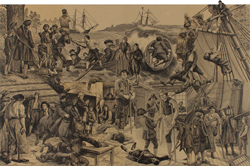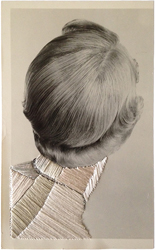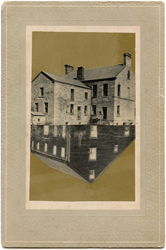April 16 - May 21, 2016
Reception: Saturday, April 16, 5-7PM
Gallery Talk with Lou Beach and Zac Thompson: Saturday, April 23, 11am
RSVP by April 22
Apropos of the current political scene in America and barbaric events worldwide, Lou Beach’s exhibition of new collages is titled, A Plague of Fools. His witty and provocative work can be compared to the robust oddities of Hannah Höch, the incisive critiques of John Heartfield and the curious fantasies of Joseph Cornell. The son of Polish parents displaced by World War II, Beach (born Andrzej Lubicz-Ledóchowski) travelled to California in 1968, began studying the Surrealists, and started making collages from LIFE Magazine. In the mid-'70s, he served as a sexton at Arlington St. Church in Boston and had his first solo exhibition at the Boston Center for the Arts. He then returned to L.A., where he built a long career creating record album covers and illustrating magazine and newspaper editorials. Beach now focuses on his collages, which art critic Peter Frank describes as “sweetly uproarious orgasms of juxtaposition.” Terry Gilliam, film director, flatly declares, Beach is “the greatest collage artist on the planet.”
Concurrently, the gallery will present, Subject Matters, an exhibition of recent collages by Stephen Aldrich. A pivotal moment in Aldrich’s career occurred in 1968 when he met the influential photographer, Frederick Sommer. A musician and art student at Prescott College in Arizona, Aldrich was soon enlisted by Sommer to interpret his innovative, abstract musical scores, thus beginning a long relationship of mentoring and collaboration. In the last decade of Sommer’s life, Aldrich worked with him on an extraordinary group of collages, while at the same time, developing his own unique approach to the medium. Working with fine 19th century engravings from books and journals as his source material, Aldrich cuts imagery with mind-boggling precision and complexity. There is an obsessive quality to the work in its overlappings, rhythms, repetitions and patterns that may, in part, be attributable to his background in music.
In New York-artist Joseph Heidecker’s first exhibition in Southern California, Figures & Faces, photographic portraits are stitched with colorful threads that pattern the face like Matisse’s famous portrait of his wife, The Green Line. They also suggest bold masks in the vein of Picasso’s Demoiselles D’Avignon. Heidecker fancies the contrast between black and white photographs and his textured, hand-crafted embellishments. He is also intrigued with exploring images that someone else has made and taking it to another place through ideas of identity, role-playing and impermanence.
Finally, the fourth in our quartet of collage artists, Zac Thompson, works with vintage found carte de visite portraits, reassembling them into a series called, False Family: The Architecture of Found Photographs. Giving context for the genesis of this work, Thompson writes:
“James W. Loewen states in Lies My Teacher Told Me, ‘How people think about the past is an important part of their consciousness.’ I grew up in a hyper evangelical southern household where I learned about things, like the destruction of Sodom and Gomorrah; towns destroyed because of their wickedness and homosexuality. This religious education influenced how I thought about myself growing up and made my decision to come out of the closet 2 years ago extremely difficult.
Acknowledging my sexual orientation heightened my awareness of the past and historical accuracy. This realization has directly influenced my work, an ongoing exploration in understanding that there is a multiplicity to the people and places in our world, despite what popular rhetoric might suggest. Primarily working with found photographs and collage, I construct false objects with an often surreal and dystopian quality. The photos and houses are like hollowed out memories that invite me to fill them with my own history and experiences.”



